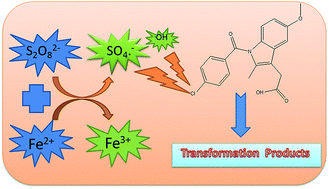A sulfate radical based ferrous–peroxydisulfate oxidative system for indomethacin degradation in aqueous solutions†
Abstract
The degradation of indomethacin (IM) by ferrous ion-activated potassium peroxydisulfate (Fe2+/PDS) was investigated. We aimed to determine the optimal conditions for the removal of IM under different concentrations of Fe2+and PDS, evaluate the effects of operational parameters (solution pH, humic acid (HA), N2 bubbling and persulfate species), and propose the degradation mechanism of IM by the Fe2+/PDS system. The sequential addition of Fe2+ led to an improvement in the IM degradation and TOC removal efficiency. When the molar ratio of IM/PDS/Fe2+ was 1 : 1.5 : 2, the IM was almost completely degraded. Restrictions to the degradation efficiency of IM were caused by increasing the solution pH, bubbling with nitrogen, or through the addition of HA. A low concentration of Cl− had no effect on the reaction, while a high concentration led to a dramatic inhibitory effect. In addition, quenching experiments revealed that SO4˙− was the major active radical for the degradation of IM by ferrous ion-activated peroxydisulfate. Based on the identification of transformation products by liquid chromatography-mass spectrometry (LC-MS/MS), the pathways of the ferrous–peroxydisulfate oxidative system for the degradation of IM were tentatively proposed.



 Please wait while we load your content...
Please wait while we load your content...